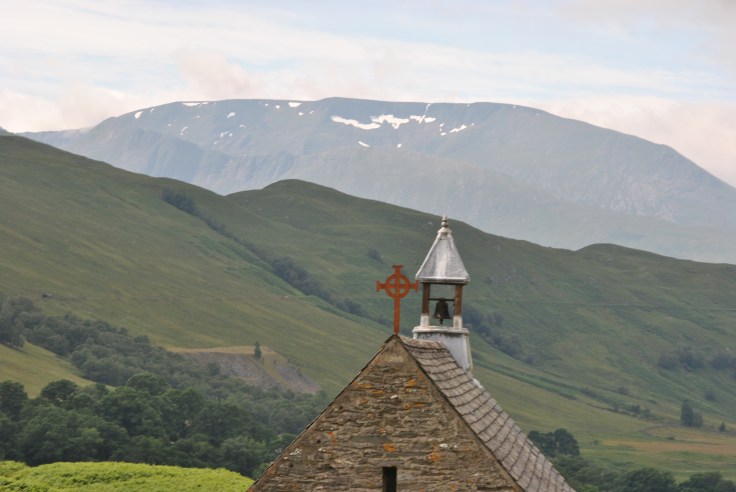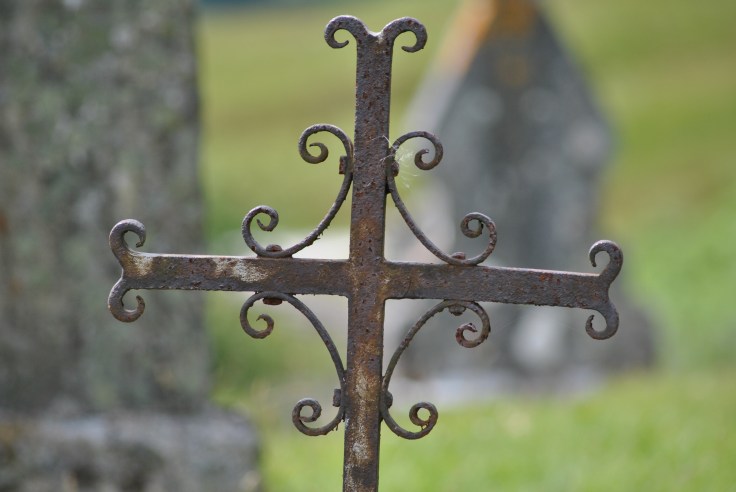Ian Lom – the poet who cut off the heads of seven murderers
It is a long and gory story that emerges from this beautiful graveyard near Roy Bridge. Stunning scenery surrounds the ancient burial place and the remains of a 15th century Roman Catholic church, Cille Choirill, a spot as beautiful as it is historically significant.
One of the most important Gaelic bards of the past is buried here. And certainly, the most intriguing. No grave remains to be visited. The Keppoch Bard died in the early 18th century at the end of a turbulent life.
Charles Fraser-Mackintosh erected a carved stone to his memory in the 19th century.
Ian Lom was not a shy, withdrawn and romantic person, he was a warrior, a fighter with a strong sense of justice, and the strength to see it served by all means available. By appearance he served the traditional stereotype of a bard – he was as his Gaelic name suggests bald, or possibly just had not many facial hair, probably had a limp and a stutter.
A man, made for the pen not the sword it seemed. But at the same time, he was physically fit and able, wandered great distances, climbed in mountainous terrain and fought in battles.
And he was high-spirited with a fiery passion for justice.
Ian Lom was also a vital part in a well-known murder story…
vengeance by pen and by knife
The Keppoch murders happened on 25th September 1663. On this autumn day, Alexander MacDonald, the 12th chief of Keppoch and his brother Ranald (both young men) were killed by rivals of another branch of the family, deadly enemies over power and land. The murder was gruesome, the two bodies were covered in bloody knife wounds.
Ian Lom’s account of the murder:
It was on Saturday, not long hence,
That the tragedy despoiled us,
As I lamented the white bodies
Losing their blood about their cloaks;
My hands were drenched crimson
After cleaning your wounds,
Putting you into a coffin
Is the worst task I have known
The English translation of the Gaelic lament is taken from: Bàird Ghàidhlig na Ceapaich
The killer, Alexander MacDougall of Inverlair, was the local Tacksman and uncle of his two victims. He and his six sons were MacDonalds, too, and they seemed to have had considerable local support. Maybe because they had taken care of the Clan in the years the young and now dead chief was abroad in Rome and France to get an education. The two young men had just returned home, and apparently they had no intention of fitting in smoothly. The uncle suddenly without power and land and two boys to answer to instead of commanding. This was a murder motive, and there was no love lost between them.
The young chief had been killed in his bed and Ian Lom was furious that no once cried out for justice. The Keppoch bard, who lived in Tulloch near Inverlair, close to what is now the Laggan dam, played a vital part in bringing the murderers to justice. He and the sister of the two murdered brothers who nearly or temporarily lost reason after having found her brothers slain. Her lament is harrowing and directed to Ian Lom. She wanted revenge and justice done. But she needed others to do that for her.
I opened the door of your chamber–
Your blood came over my shoes.
I scarcely refrained from drinking my fill of it.
It is the blood of Alexander that grieved me
And the blood of brown-haired Ranald the younger.
The fate of the black singed pig
Be upon all who were concerned in the butchery.
Convey a message from me to MacDonald (I.e. of Sleat),
To MacDonald of Glengarry from Knoydart,
And to MacDonald of Clanranald from the open sea.
In the King of Glory I trust
That you will avenge them—
They were your relatives and my brothers.
a lament for justice
And what did the bard do? He composed an irresistibly poignant lament Cumha Clann na Ceapaich (The Lament of the Clan Keppoch) on the death of the young chief and his brother. And poetry worked its cause. This pen wasn’t mightier than the sword, but it made sure that swords would be provided. All he needed was patience. But he had none and he was facing nothing but indifference.
The Bard went to the MacDonald of Glengarry and asked for justice. A futile trip. Glengarry chose to believe it had been an accident. He wouldn’t even act after the Privy Council in Edinburgh asked him to look into the matter since he was the most powerful MacDonald near and far.
So Ian Lom went all the way to the Isle of Skye to ask the MacDonald of Sleat for help. And Sir James MacDonald of Sleat granted it after having received a death list from the Government. An order he was given…
“on the 29th of July 1665, listing the following persons to be put to fire and sword:
Allan MacDonald, son of the Tutor of Keppoch;
Donald MacDonald, brother of Allan
Alexander MacDougall in Inverlair
John Roy MacDougall, brother of Alexander
Donald Orie McCoull
Dugall McCoull in Tallie
Patrick Dunbar. “
(Bàird Ghàidhlig na Ceapaich)
to kill the murderers
Sir James despatched a force of about 50 men (some were summoned from as far as Uist) to administer justice in the glen in 1665.
“The party which he despatched from the isles, starting on a Wednesday, and on Sunday morning before daybreak, the whole of the conspirators, except Alasdair Mòr (Alexander of Inverlair), were surprised and killed and their houses set on fire. Alasdair Mòr had retired to his cottage, which he had some time previously loopholed and fortified, and now, with the help of his wife, he was ready to offer a determined resistance. His assailants were unable to effect an entrance. Many of them were killed or sorely wounded by the hot fire which Alasdair kept up from the bothy, ably assisted by his courageous wife, who, though her leg had been shattered by a ball early in the fight, continued to load his rifle and mould his bullets. At last, one of the attacking party managed to place a large bundle of bracken and dry heather under the eaves of the roof, and, quickly setting fire to it, retired unhurt. Alasdair, suffocated by the smoke office now burning house, and feeling that his last hope was gone, seized his wife in his arms, and, rushing from the door, or someone cut to pieces by his assailants.”
(Place-Names of Glengarry and Glenquoich)
7 heads for Glengarry
The seven murderers were killed after this surprise attack near the graveyard and the bard who lived close, severed their seven heads with the knife they had used to kill the young chief and his brother. A bloody task for a poet to perform. And no romantic yarn either. A few hundred years later 7 beheaded skeletons were found in a grave there.
“In the middle 19th Century, a Dr. Smith of Fort William who questioned the authenticity of the story, traveled to the mound where the decapitated bodies of the murderers were known to have been buried. Upon excavation, he discovered seven headless skeletons, one of which he was able to determine was that of MacDonald of Inverlair.”
Professor John Duff: The Sister’s Lament—A Tale of Beauty and the Beasts.
Then Ian Lom took the seven heads to Glengarry, as a reminder to the chief of how justice should have been done. He cleaned himself of their blood on the way near Invergarry. The well where that happened is still called “The Well of the 7 Heads” (Tobar nan Ceann). A monument sits right next to the A82 south of Invergarry.
Liked the read? There’s more here...

Scotland is a country full of history, stories and secrets. Often, the three cannot be separated. That is what makes this country so wonderful and unique. The stories of this book have been discovered and gathered for Erkenbach’s blog, Graveyards of Scotland, over many years.
Her main sources were historical travel guides from the 18th and 19th centuries, where the finds were scary, beautiful, funny, and sometimes, cruel.This unusual approach to a country’s history has produced amazing results. You don’t have to share the author’s passion for cemeteries to enjoy this book; only a small number of the stories in this collection take place in graveyards, though they do all end in them, so perhaps it helps.
The fairy hill in Inverness, a nitrate murder on Shetland, a family of left-handers, wolves, Robert the Bruce and William Wallace shown in a new light, the secret bay of the writer Gavin Maxwell, a murdering poet and so many things you didn’t know about Scotland, its clans and its history.
Sources and further reading:
Edward C. Ellice: Place-Names of Glengarry and Glenquoich and their Origin. London, Swan, Sonnenschein, 1898
















Leave a comment